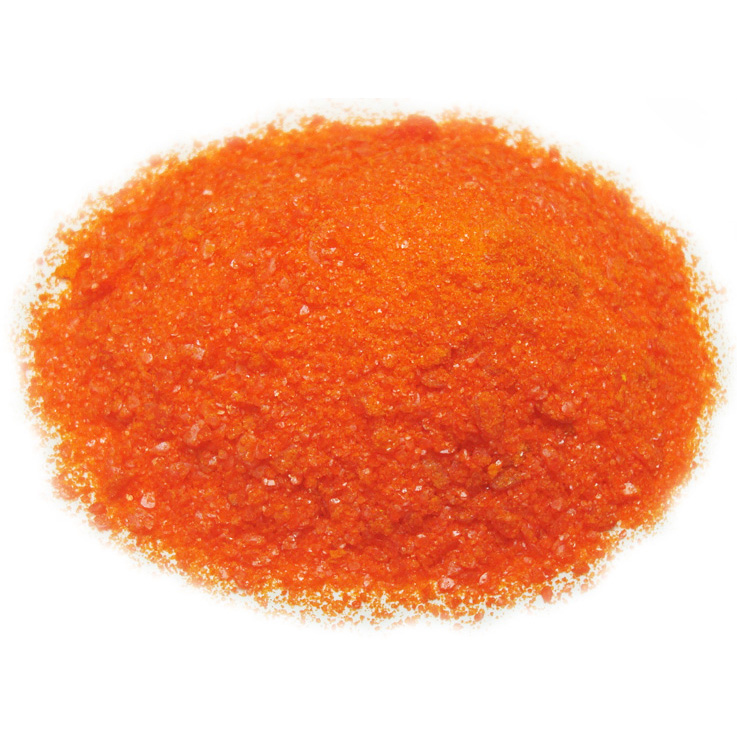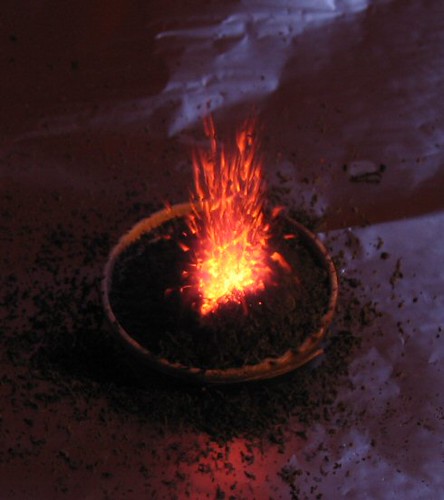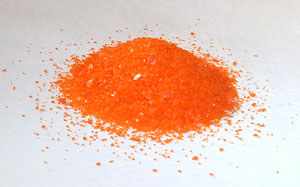Ammonium dichromate
- Ammonium bichromate
- Double Chromate Ammonium
Orange, odorless crystals
Fixed
2.15 g · cm -3
180 ° C ( Explosive decomposition)
Well in water (360 g · l-1 at 20 ° C)
Risk
53.75 mg · kg -1 ( LD50, rat, oral)
Template: Infobox chemical / molecular formula search is not possible
Ammonium dichromate is an ammonium salt of dichromic acid. It has the formula ( NH4) 2Cr2O7.
Properties
Ammonium dichromate is an orange powder that is readily soluble in water.
Due to its composition of an easily oxidizable cation ( ammonium ion ) and a strong oxidizing agent ( dichromate ) it can decompose exothermically.
The most famous experiment on decomposition of crystalline ammonium dichromate is the volcano experiment. Here, a larger crystal or a small pile is ignited above. After ignition, the reaction proceeds with lively glow, noise continued ( evolution of nitrogen ) and the formation of loose gray-green dichromium. The dichromium trioxide formed Wells such as volcanic ash from the reaction site so as to form a cone. The corresponding reaction equation for this reaction is:
The volcano experiment is forbidden in German schools due to the formation of chromium ( III) chromate.
Overall, ammonium dichromate is a strong oxidizer, such as finely divided metal powders with strong reducing agents, sulfur, or phosphorus very violent ( explosive) responding ( R8).
Because of its ionic nature and trained in water dissociation equilibria affects the ammonium dichromate corrosive ( R34).
Explosive properties
Ammonium dichromate decomposes above 100 ° C exothermic; the reaction proceeds explosively from 240 ° C. In an initial ignition by means of picric acid it detonates only partially under confinement.
The sensitivity to mechanical stress is extremely low. Thus, ammonium dichromate does not react when rubbed in a mortar nichtglasierten; the sensitivity to impact is roughly equivalent to that of ammonium perchlorate (15 cm under a 10 kg drop hammer; does not classified as explosive ammonium nitrate detonated, the 10 kg drop hammer from a height of 20 cm). The detonation propagates even under optimal conditions only on very short distances away: H. Kast: "Under the Wrkg. the detonation of picric acid 30g pressed on to a 4 cm wide, 4 mm thick and 18 cm long tube (presumably Zn tube) stuffed salt occurs only along a short distance decay of the verb with an 'in: Z. ges. Shooting explosive nature. 22 6/9.
Ammonium dichromate is not explosive, but is isolated in pyrotechnics and as a catalyst in propellants ammonium nitrate-based use.
Toxicology and Ecotoxicology
Ammonium dichromate is toxicologically classified by the EU Commission:
Carcinogen category 2 (R45: May cause cancer. )
Mutagen category 2 ( R46: May cause heritable genetic damage. )
Toxic to reproduction category 2 ( R60- 61: May impair fertility and may cause harm to the unborn child. )
Furthermore, it is very toxic by inhalation ( R26 ) and classified toxic if swallowed (R25 ). Contact with the skin is considered harmful to health (R21 ). Another danger of ammonium dichromate, the possibility of sensitization by inhalation and skin contact ( R42/43 ) dar.
Ecotoxicologically it is considered very toxic to aquatic organisms and may have a longer-term harmful effect on the aquatic environment ( R50/53 ). In the Administrative Regulation on substances hazardous to water (Self July 2005) is ammonium dichromate in the highest water hazard class 3 with the identification number 290. Due to the reported in the literature bioconcentration factor of 200-2000 an accumulation in organisms is possible.
Use
- In photography, holography and the Darkroom procedures ( especially in light printing and rubber printing as well ( together with gelatin, polyvinyl alcohol and possibly dyes) the so-called " dichromated gelatin " ( DCG ) holograms ):
Ammonium dichromate tans with exposure to light gelatin or other colloids, making them sensitive to light and after exposure and development even for color layer or the color carrier or hologram.
- In pyrotechnics.
- For the manufacture of wood preservatives for industrial application.
- For the preparation of chromium ( IV) oxide for magnetic storage media.
- For the preparation of catalysts for organic syntheses.
Special legal regulations
Ammonium dichromate is subject to the Chemicals Prohibition Regulation, the Water Resources Act and the Explosives Act. In industrial quantities moreover, it is subject to the Hazardous Incident Ordinance.
Furthermore, there are employment restrictions for young people ( youth employment law ), as well as for expectant and nursing mothers ( Maternity Protection Directive ).









